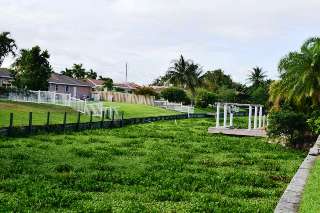|
Article Courtesy of The Palm Beach
Post
By Alexandra Seltzer
Published June 21, 2016
Waterfront property owners in the south part of Boynton Beach
near Lake Ida noticed in January that their canal had become overgrown with
vegetation.
Six months later, the normally clear water has been taken over by such growth —
described by residents as water lettuce and hydrangeas — that it looks like a
layer of grass instead.
|
The four canals just east
of the Diane Drive canal also had the same problem, leaving
those residents turning to the city with the same questions:
Where did this come from? Why aren’t you helping?
“It’s been pretty frustrating,” resident Beth Bernet said. “This
vegetation grows just unbelievably.”
The land was not owned by the city, which had no obligation to
help, but still did pitch in, until this year.
The city and the homeowners had a five-year plan that started in
2010 where Boynton maintained fresh-water canals by spraying an
organic chemical that kills and decomposes exotic vegetation.
The city added a .25 cent surcharge per resident on the
storm-water fee.
That program, however,
expired at the end of this past year. Not all residents were
notified, said Colin Groff, the city’s director of utilities and
an assistant city manager. |
|
The canal east of Diane Drive is the worst of the five in
terms of maintenance.
|
Boynton’s original five-year deal included work on both public and these five
private canals. That agreement, however, expired and the city is reluctant to
extend it because technically it can’t use public money to maintain private
properties — which the canals are. Five years ago, the city deemed it OK to help
out with money for the private canals because “it was a public benefit to
include these canals,” Groff said.
Some residents acknowledge the canals are private but say the city still has an
obligation to help. There are no homeowners associations in these neighborhoods,
making it difficult for residents to forge forward a plan.
Those who live on the two canals south of Southwest 34th Avenue acted quickly.
They came together without help from the city and paid a company to take care of
the problem. Those canals are now clear.
+Will city help Boynton residents with overgrown green canals? photo
The canal east of Diane Drive is the worst of the five in terms of maintenance.
Photo handout: City of Boynton ... read more
The two canals north of there — south of Mission Hill Road — have yet to do
anything, Groff said. The vegetation is overgrown and has taken over in some
areas, but it’s nothing compared to the 1,900-foot canal near Diane Drive.
Vegetation is so thick there, residents have had to harvest the vegetation by
forcefully removing it. The clumps are then brought to the right-of-way where
the city then legally picks it up and disposes of it.
Clearing that canal could take weeks.
“It still looks like you could walk across it,” Resident Chuck Bolt said.
Bolt said the city should pay to get the canals clear, and then he would feel
comfortable taking it over. He also described the canal as “quasi public.”
“There’s jetskiiers, the best fishing. It’s open to the public but we do own it.
It’s kind of an oxymoron,” said Bolt, who has lived at his home for 23 years.
“People at the north end can’t use boats, no jet-skis, no nothing.”
+Will city help Boynton residents with overgrown green canals? photo
The canals north of Southwest 34th Avenue are in the process of being fixed.
Photo handout: City of Boynton Beach
The city’s elected officials will discuss how to move forward Tuesday at the
city commission meeting. A permanent fix could result in the city creating a
taxing district to gather money to maintain the canals, Groff said.
Meanwhile, the city has met with some residents and is helping in whatever ways
they can.
“It’s a very good cooperative effort between the city and the homeowners to take
care of a problem, that is a problem, and the city recognizes it is a problem,
but unfortunately it is private property,” Groff said. “When people bought those
homes they bought that canal… just like you do in a subdivision and there is a
lake. You own the lake and you have to take care of the lake. It’s no
different.” |
